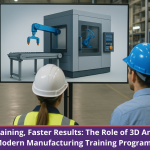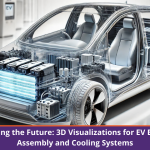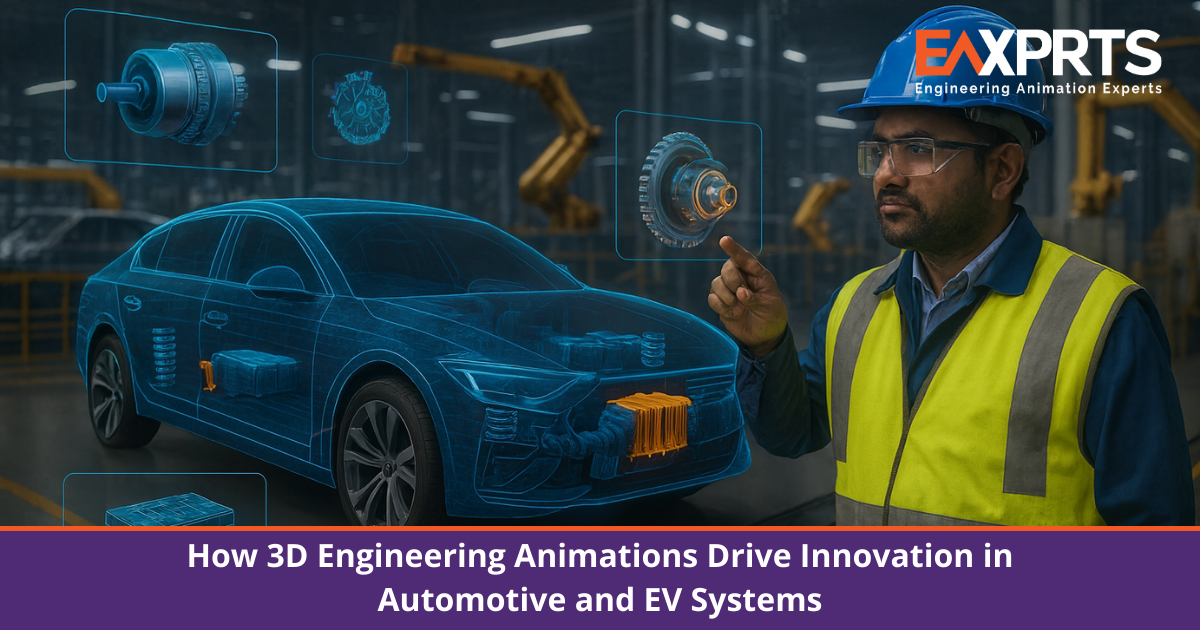
Smarter Training, Faster Results: The Role of 3D Animation in Modern Manufacturing Training Programs
August 26, 2025
Powering the Future: 3D Visualizations for EV Battery Assembly and Cooling Systems
September 3, 2025How 3D Engineering Animations Drive Innovation in Automotive and EV Systems
The automotive industry is undergoing its most significant transformation in a century. From the shift toward electric vehicles (EVs) to the rise of autonomous driving systems, innovation is no longer an option, it’s a necessity. As companies race to develop safer, smarter, and more sustainable mobility solutions, they face mounting challenges in design, manufacturing, training, and customer engagement.
This is where 3D engineering animation steps in as a game-changer. By providing precise, realistic, and interactive visualizations of complex systems, 3D animation is helping automotive and EV companies accelerate innovation, improve efficiency, and strengthen customer trust.
The Role of 3D Engineering Animation in Automotive Innovation
At its core, 3D engineering animation bridges the gap between design concepts, engineering blueprints, and real-world applications. Unlike static drawings or traditional CAD models, animations bring mechanical and electrical systems to life, making it possible to visualize functionality, assembly, and performance in a dynamic, engaging way.
In the fast-moving world of automotive R&D, this means:
- Faster prototyping and shorter development cycles.
- Improved collaboration between OEMs, Tier-1 suppliers, and engineering teams.
- Clearer communication of design intent, minimizing misunderstandings and costly errors.
3D engineering animations are no longer just marketing assets—they are strategic tools that support every stage of automotive and EV system development.
Applications of 3D Animation in Automotive & EV Systems
- Concept Design & Visualization
During early design phases, 3D animation allows engineers to explore multiple concepts without building physical prototypes. For EVs, this includes:
- Visualizing battery pack structures, cell configurations, and thermal cooling designs.
- Demonstrating power electronics layouts and inverter designs.
- Showcasing vehicle aerodynamics and energy efficiency concepts.
By animating these systems, design teams can validate ideas quickly and communicate them effectively to stakeholders and investors.
- Assembly & Manufacturing Processes
One of the biggest challenges in EV production is assembling highly complex systems like wire harnesses, battery modules, and electric drivetrains. With 3D assembly animations, manufacturers can:
- Train operators using step-by-step visual guides.
- Optimize assembly line workflows before production begins.
- Reduce trial-and-error costs on the shop floor.
For example, an animated guide showing the correct sequence for assembling a battery cooling plate can prevent errors that would otherwise cause costly rework.
- Maintenance & Service Training
EVs and modern vehicles require advanced training for technicians. Traditional manuals often fail to capture the complexity of high-voltage systems, regenerative braking, or motor controllers.
3D animated training modules provide:
- Interactive troubleshooting for faster diagnosis.
- Realistic visualization of component replacement and repair.
- Safer learning environments for high-risk procedures, such as disconnecting a lithium-ion battery system.
This reduces downtime, boosts technician confidence, and ensures customer satisfaction.
- Safety & Compliance
Automotive systems must meet strict safety and compliance standards. 3D engineering animations help companies demonstrate compliance effectively by:
- Visualizing thermal runaway prevention in EV batteries.
- Explaining safety features like airbag deployment or ADAS (Advanced Driver Assistance Systems).
This not only satisfies regulators but also reassures customers about product safety.
- Customer Education & Marketing
Most consumers struggle to understand how EV systems work. Concepts like regenerative braking, battery charging cycles, and electric drivetrains can feel abstract.
With 3D animations, brands can simplify the message and build trust.
- Marketing teams use animations to showcase EV advantages.
- Dealerships use them to explain features during the sales process.
- Brands leverage them in digital campaigns to differentiate from competitors.
By turning technical complexity into visual storytelling, companies gain a powerful tool for customer engagement.
Benefits of Using 3D Engineering Animation in Automotive & EV Development
- Faster Product Development Cycles
Visual prototyping reduces dependency on physical prototypes, saving time and cost. - Reduced Training Costs
3D animated modules replace expensive in-person workshops and physical demo kits. - Improved Communication Across Global Teams
Suppliers, OEMs, and engineers collaborate more effectively using visual content. - Regulatory & Safety Compliance
Complex compliance demonstrations are simplified through animations. - Enhanced Customer Engagement
Customers gain confidence when complex EV systems are explained visually. - Lower Downtime in Service & Maintenance
Animated troubleshooting ensures technicians resolve issues faster and safer.
Case Examples of 3D Animation in Automotive & EV
- Battery Management System (BMS): Animations illustrate how a BMS monitors cell voltages, balances charging, and ensures safety in real time.
- Electric Drivetrain: Visualizing the interaction between electric motors, gearboxes, and inverters helps engineers fine-tune performance while training technicians.
- Autonomous Systems: 3D animations demonstrate how LiDAR, radar, and cameras work together in sensor fusion for ADAS and self-driving.
Aftermarket Support: Spare part animations and digital service guides improve aftermarket efficiency and enhance customer loyalty.
The Future of 3D Engineering Animation in EV Innovation
The automotive industry is entering the era of Industry 4.0, and 3D animation will play an even greater role:
- AR/VR Training: Immersive training will let technicians practice complex repairs in a safe, virtual environment.
- AI-Powered Animation Pipelines: Artificial intelligence will reduce animation production time, enabling faster content creation.
- Sustainability Storytelling: Visualizing the EV lifecycle—from raw material sourcing to battery recycling— will help companies communicate sustainability efforts.
The future is clear: 3D animation will be a key enabler of innovation, efficiency, and trust in the automotive and EV sector.
Conclusion
As the automotive industry transitions to electric and autonomous vehicles, the complexity of systems will continue to grow. From battery engineering to autonomous driving, every step requires clear communication, precise training, and faster innovation cycles.
3D engineering animation delivers on all these fronts—driving efficiency in design, safety in operations, and trust in customer engagement. For automotive OEMs, Tier-1 suppliers, and training providers, investing in 3D animation is no longer optional; it’s a competitive advantage.
If you want to showcase your automotive innovations, streamline training, and engage customers with confidence, partner with experts in 3D engineering animation for automotive and EV systems.
Talk to us today! Reach us on sales@eaxprts.com



